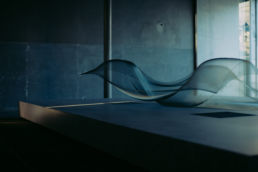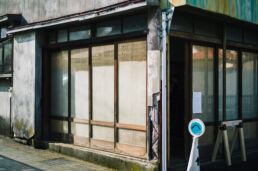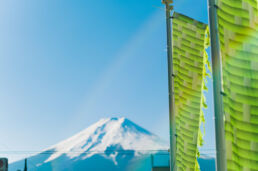FUJI TEXTILE WEEK was held from 19 December 2021 to 9 January 2022.
The event exhibited textile-based artworks in vacant buildings and galleries dotted around Shimoyoshida. In addition to exhibiting works by internationally-renowned artists, talk events by participating artists were held for three days from the first day of the exhibition and visitors could view the works as they pleased while passing by with a map in hand. Winter is also the season when Mt Fuji can be seen clearly, so visitors must have enjoyed the magical scene of the cityscape, art and Mt Fuji.
SARUYA HOSTEL representative Yagi was the initiator of this project, and SARUYA HOSTEL was also part of the base, but how was this event, which ended well received, born and how will it lead to the future of the town and the inn? We would like to tell you about the event and what happened during the Fuji textile week.
What if the exhibition was held in the 'production area'?
The impetus for holding FUJI TEXTILE WEEK came in the spring of 2020, when the new corona virus began to spread in Japan in earnest and a large-scale textile exhibition that is normally held in Tokyo was cancelled. However, on reflection of this cancelled event, it became clear that the conventional way of doing things was not without its problems.
It is true that large-scale exhibitions held in urban areas have the advantage of bringing together a large number of traders and buyers and enabling efficient business negotiations. However, no matter how ingenious the exhibition method, there was a sense of frustration that it was impossible to convey the background to the product or the atmosphere in which the product was born in an inorganic venue, such as Tokyo.
Then, what if the exhibition was held in the ‘production area’?
Not only was viral infection more limited in Yamanashi Prefecture than in Tokyo, but the products could be seen in the scenery of the town where they were born. Although there are difficulties in getting buyers to go out of their way to visit the exhibition, holding the event in the production area would make it possible to convey the background and atmosphere of the product much more accurately than in an inorganic venue.
The plan, which began with such an idea, came to fruition in 2021 with further cooperation from various quarters and was held simultaneously with the art event at this time. The idea was that by introducing textiles within the format of an art event, it might be possible to highlight not only textiles as products, but also the artistic aspect of textiles.
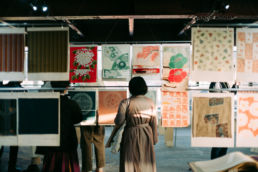
There are several examples, such as the Milano Salone in Italy, where ‘industry’ and ‘art’ of a country or region are treated in a close context. The FUJI TEXTILE WEEK also contains such a message to the participating artists.
At the exhibition held during the exhibition period, we reduced the number of fabric samples and focused on showing materials and elements, whereas in the past we would have comprehensively lined up fabric samples. While struggling with this unprecedented method of display, we believe that visitors of the exhibition were able to see the company’s products from a different perspective and make new discoveries. Tatsuyasu Watanabe by Watanabe Taxtile and Miyashita Orimono also exhibited textiles and costumes they have worked on as one of the participating artists. The exhibition was well received by the art and design professionals who visited and one designer, who travelled from Tokyo just to see one of the works, let out a sigh of admiration in front of it.
An archive of fabrics that was woven in the city was also displayed in one section of the exhibition space. The name of Hataya’s company, which probably no longer exists, is also listed there. It is said that there used to be as many as 6,000 textile-related companies in Fujiyoshida and so a large proportion of the population must have been involved in the textile industry in one way or another. However, the number has now been reduced to about 200 companies. Even so, when I see the local people at the exhibition proudly and nostalgically saying things like ‘I wove this’, I realise how deeply textiles have taken root as part of the town’s identity.
For those who were born and raised in the town, the sound of looms echoing through the town and Mt Fuji sitting at the end of the shopping street are everyday sights. However, they have rarely had a bird’s-eye view of the town’s landscape and its textile industry at the same time. Through the event and through the sight of people who went out of their way to see the textiles, the familiar scenery may have been seen in a different colour. In case it did, the FUJI TEXTILE WEEK may have brought about some changes in the impressions of the local area as seen by the people of the town.
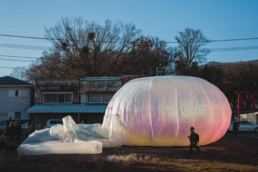
I visited the exhibition twice and was surprised again by the vividness and novelty of textiles woven decades ago, the variations and technical skills of the Hataya artists who are active today, and above all, the way the visitors took their time to look at each textile one by one. It was a joy to see visitors taking their time to look at the textiles one by one. At the talk event, people wearing the same designer’s stole mingled with each other, and the usually deserted winter shopping street was filled with the lively voices of children and a warmth that made the cold seem less bothersome.
When the new virus is over, the large-scale exhibitions in Tokyo may return, but nonetheless, this event has brought a great deal to the production area. The virus threat is likely to continue for some time yet, and there are many other concerns in the world. The Japanese textile industry itself does not have a bright future. Even so, I feel that this town has developed a core strength that is not easily daunted by crisis. I would like to continue to enjoy the changes in this town while looking forward to the realisation of the second and subsequent FUJI TEXTILE WEEK.
Written by:
Saruya Hostel
Helping to reanimate our neighborhood and city, partnering with local businesses, renovating old houses and furniture to give them a new life, those are the things that drive us at Saruya. We like to talk about those things here on this blog.


